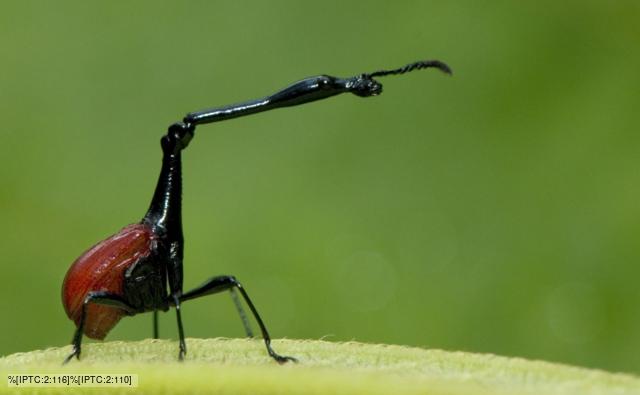-
Welcome to Smogon! Take a moment to read the Introduction to Smogon for a run-down on everything Smogon, and make sure you take some time to read the global rules.
-
Congrats to the winners of the 2023 Smog Awards!
Nerd Animal Thread (Animal Facts you Know and Love)
- Thread starter Chou Toshio
- Start date
Did you fail that assignment due to propagating a myth, or did your teacher not actually care about the validity of your claims?I wrote a like 5 page essay about a fish in the Amazon River and can swim up a stream of urine into your penis where it hooks itself in and sucks your blood. I'm not even kidding. Its called a candiru and its kinda frikin scary. It is the only vertebrae that is parasitic to humans. Its has two common nicknames: the penis fish, for reasons outlined above, and the toothpick fish, because of its very small size. It can also make its way into the gill of a fish and suck blood from there.
I would give a link but I'm on my phone. :P
pretty sure it can't swim up a stream of urine >_>
vampire bats also have vertebrae and im pretty sure are classified as parasites, then again id have to check if they ever bite people (this penis fish surely doesn't often latch onto dicks either though)
vampire bats also have vertebrae and im pretty sure are classified as parasites, then again id have to check if they ever bite people (this penis fish surely doesn't often latch onto dicks either though)
Maybe biggest dicks, but wayyyy smaller balls.humans have the biggest dicks of all primates.
actually, i received a very good grade on the assignment. i didnt mention swimming up a stream of urine as i thought it might be inappropriate for schoolDid you fail that assignment due to propagating a myth, or did your teacher not actually care about the validity of your claims?
it can also leave bullet like holes in the skin of its victims
:/
Belongs in the dog thread dude. If you wanna post about dogs in this thread, should be like this:
The Saluki is the first recorded dog in history, bred in Egypt and appearing in records from thousands of years ago. Despite these ancient origins, the Saluki is an incredibly specialized hunting dog, highly modified from the wolf.
Seeing a Saluki, the first thing one will notice (compared to wolves) is it's long body and unique gate-- when running at top speed, all legs come off the ground at once 2 times in each stride, and it seems to float-- it has one of the longest strides in the canine world, and longer than any wild canid. The wolf's maxed-out sprinting speed is 35 MPH-- which happens to be the Saluki's base running speed, which it can maintain almost endlessly. At a top sprint, the Saluki will easily jump over 40 MPH. The Saluki line was used to breed the fastest dog-- the greyhound.
But what makes the Saluki really unique is it's vision-- usually considered a dog's weakest sense, Salukis have a powerful ocular ability. There forward facing eyes have binocular vision comparable to a human's, but their vision is wider and catches 40 more degrees than human site.
This vision, combines with their great height, makes them extremely effective at finding prey out in the dessert.
A special body, unique running style, and muscular and sensory abilities far exceeding the wolf. The ability bred by our ancestors thousands of years ago makes up for a dog we can love and respect even in this age.
The Saluki is a far superior hunter to the wolf, especially on flat terrain. However, where man has succeeded in breeding an incredible hunter with a far higher success rate, like cheetahs, the added speed and success of kill comes along with an inferior fighting ability-- the Saluki would be screwed in a territorial dispute with stalkier, stronger predators. They might also have trouble taking down larger prey, such as the elk North American wolves specialize in. Of course, where the speed-specialized cheetah's biggest downfall is worrying about having kills stolen by other predators, the Saluki, backed by human hunters, doesn't have to worry about this.
Such is the result of man's brilliance and care to bring such a creature into existence.
Belongs in the dog thread dude. If you wanna post about dogs in this thread, should be like this:
The Saluki is the first recorded dog in history, bred in Egypt and appearing in records from thousands of years ago. Despite these ancient origins, the Saluki is an incredibly specialized hunting dog, highly modified from the wolf.
Seeing a Saluki, the first thing one will notice (compared to wolves) is it's long body and unique gate-- when running at top speed, all legs come off the ground at once 2 times in each stride, and it seems to float-- it has one of the longest strides in the canine world, and longer than any wild canid. The wolf's maxed-out sprinting speed is 35 MPH-- which happens to be the Saluki's base running speed, which it can maintain almost endlessly. At a top sprint, the Saluki will easily jump over 40 MPH. The Saluki line was used to breed the fastest dog-- the greyhound.
But what makes the Saluki really unique is it's vision-- usually considered a dog's weakest sense, Salukis have a powerful ocular ability. There forward facing eyes have binocular vision comparable to a human's, but their vision is wider and catches 40 more degrees than human site.
This vision, combines with their great height, makes them extremely effective at finding prey out in the dessert.
A special body, unique running style, and muscular and sensory abilities far exceeding the wolf. The ability bred by our ancestors thousands of years ago makes up for a dog we can love and respect even in this age.
The Saluki is a far superior hunter to the wolf, especially on flat terrain. However, where man has succeeded in breeding an incredible hunter with a far higher success rate, like cheetahs, the added speed and success of kill comes along with an inferior fighting ability-- the Saluki would be screwed in a territorial dispute with stalkier, stronger predators. They might also have trouble taking down larger prey, such as the elk North American wolves specialize in. Of course, where the speed-specialized cheetah's biggest downfall is worrying about having kills stolen by other predators, the Saluki, backed by human hunters, doesn't have to worry about this.
Such is the result of man's brilliance and care to bring such a creature into existence.
Last edited:
Cresselia~~
Junichi Masuda likes this!!
Stejneger's beaked whale have blue-green milk. The blue-green colour comes from biliverdin in the milk.
http://www.ncbi.nlm.nih.gov/pubmed/6509923
http://www.ncbi.nlm.nih.gov/pubmed/6509923
K finally going to start this post after like a week of putting it off. Trying to avoid gushing about these animals is very hard.
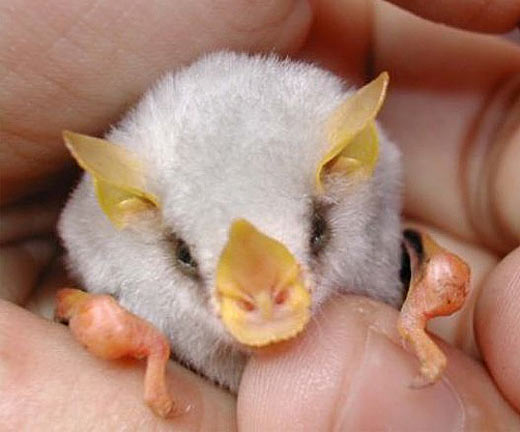
This is the Honduran White Bat, and for those wondering yes this is an adult of the species, they really are that tiny. They range from about 3 to 5cm long and weigh about 2 grams and are one of only two bat species that have completely white fur, the second being the Northern Ghost Bat (they're not albinos, HWBs even have black wings). These guys are one of about 15 species of South and Central American bats that do not roost in caves, but instead roost under leaves, like so:
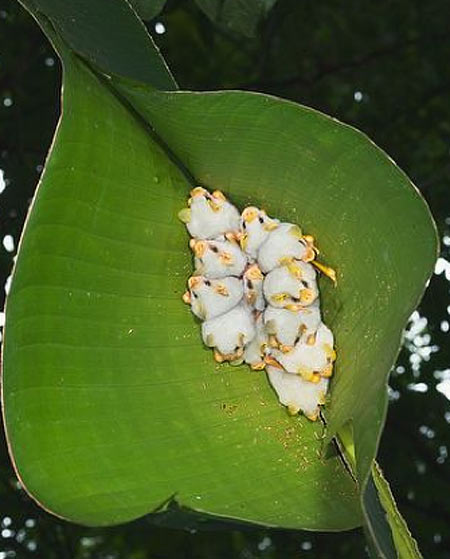
They're referred to as tent-making bats. It's actually a really smart system for these guys in particular! What they do is find a leaf, and then bite holes along the stem so they can hold on. This also usually causes the leaf itself to droop over them so they can't be seen from above or from the sides. What makes this system work so much better for HWBs is that when sunlight filters through the leaf, due to their fur colour they appear green to anything looking up at them. This may be the reason why they are the only species to not take flight when any part of the leaf is jostled, and instead only do it if the stem itself is interfered with in some way.
I've found conflicting information re: their social structures, as some places claim they live in harems (one dude, lots of lady bats) with non-harem males either living alone or with other dudes, while others claim that their groups are mixed in general and males only leave their groups when the ladies have young with them. I suspect it's more likely the former structure (since there's slightly more information about them) but who knows! The groups tend to be between 4 and 8 members, but can go as high as 12 and there are plenty of solo bats as well.
Bats come in two major suborders, Microchiroptera or Megachiroptera... or alternatively, microbats or megabats. The major differentiation between microbats (which HWB are) and megabats is their use of laryngeal echolocation, which I'm sure most of you already understand the basics of. These guys are nocturnal like a lot of bats, but only feed on fruit. They are also the inspiration for my favourite pokemon Woobat. So cute ;3;
In closing, please enjoy this complimentary bat penis.
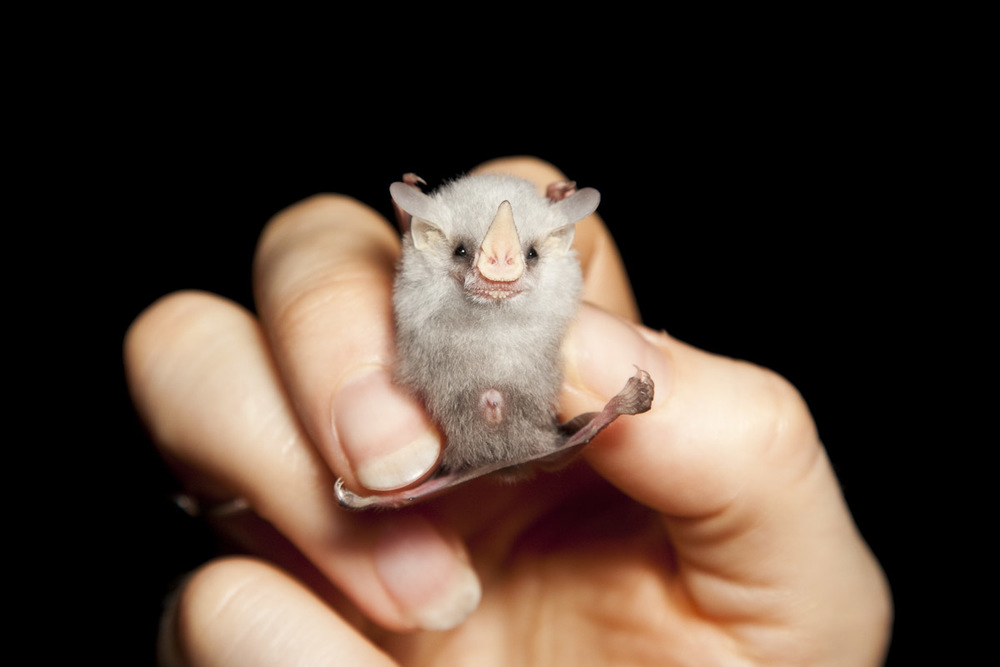

This is the Honduran White Bat, and for those wondering yes this is an adult of the species, they really are that tiny. They range from about 3 to 5cm long and weigh about 2 grams and are one of only two bat species that have completely white fur, the second being the Northern Ghost Bat (they're not albinos, HWBs even have black wings). These guys are one of about 15 species of South and Central American bats that do not roost in caves, but instead roost under leaves, like so:

They're referred to as tent-making bats. It's actually a really smart system for these guys in particular! What they do is find a leaf, and then bite holes along the stem so they can hold on. This also usually causes the leaf itself to droop over them so they can't be seen from above or from the sides. What makes this system work so much better for HWBs is that when sunlight filters through the leaf, due to their fur colour they appear green to anything looking up at them. This may be the reason why they are the only species to not take flight when any part of the leaf is jostled, and instead only do it if the stem itself is interfered with in some way.
I've found conflicting information re: their social structures, as some places claim they live in harems (one dude, lots of lady bats) with non-harem males either living alone or with other dudes, while others claim that their groups are mixed in general and males only leave their groups when the ladies have young with them. I suspect it's more likely the former structure (since there's slightly more information about them) but who knows! The groups tend to be between 4 and 8 members, but can go as high as 12 and there are plenty of solo bats as well.
Bats come in two major suborders, Microchiroptera or Megachiroptera... or alternatively, microbats or megabats. The major differentiation between microbats (which HWB are) and megabats is their use of laryngeal echolocation, which I'm sure most of you already understand the basics of. These guys are nocturnal like a lot of bats, but only feed on fruit. They are also the inspiration for my favourite pokemon Woobat. So cute ;3;
In closing, please enjoy this complimentary bat penis.

Wait, so the megabats don't echolocate?
Also, not that you can't gush-- just don't ONLY gush :p
Also, not that you can't gush-- just don't ONLY gush :p
They actually don't! Well, I believe there's one species that is an exception but it uses a different form of echolocation... something to do with tongue clicks? I'm not 100% sure. Evolutionary speaking, I'm under the impression that all bats started with echolocation and it was eventually lost in megabats, which may have something to do with their size but most likely has more to do with the fact that they're all fruit or nectar eaters and something so expensive energy-wise isn't as worthwhile as just having a good sense of smell. Microbats have more varied diets. Interestingly, all nectarivorious bats play an important part in plant pollination (along with some birds) and fruit eaters like the HWB are involved with plant dispersal.Wait, so the megabats don't echolocate?
Since I like adding pictures of cute animals, here is a baby(!) orphaned microbat that I found a few months ago. Not sure what species. Also, just a reminder for everyone living in Aus (possibly other places too) that you should never directly touch a bat and if you HAVE to handle it, always wear gloves or keep a thick layer between you and it because directly touching them means that the bat has to be euthanised (edit: this is false, being bitten/scratched = euthanasia, it's just recommended to not touch them to avoid that happening!). There are usually bat rescue people that you can call to take the bats away who will either care for them or release them back into the wild.

Last edited:
Why will a bat have to be euthanized? is it easy to crush it's bones or something?
Great facts btw
Great facts btw
Well, the main reason is that if you're bitten or scratched by a bat in Australia they have to kill it in order to test it for Australian Bat Lyssavirus, which is a close relative of rabies and the only type of rabies-like virus in Aus. It's basically for your own safety and that of the bats to not touch them directly.Why will a bat have to be euthanized? is it easy to crush it's bones or something?
Great facts btw
Edit: Whoops just realised I myself was spreading misinformation, touching a bat doesn't = euthanasia, but it's just recommended NOT to touch them if you can avoid it because sick and injured bats (less so with baby orphans) are very likely to struggle and to attack you for what are probably obvious reasons. It's better to leave the handling to someone vaccinated against ablv!
Last edited:
May i ask a question? What is this insect called in English?


It is close to these guys

The 2 lovers are locust/grasshopper, right?


It is close to these guys

The 2 lovers are locust/grasshopper, right?
What's the Latin/scientific name?
Protip: Wikipedia is a pretty good translator if you use the alternative language pages
Yes, grasshoppers
Protip: Wikipedia is a pretty good translator if you use the alternative language pages
Yes, grasshoppers
These 2, in my country, have mix up name. In the North they call the pointy head "Cào cào" and the blunt head "Châu chấu", but in the South it reverse. And my language wikipedia page about these 2 only provide Latin name for the blunt head, not for the pointy head one.What's the Latin/scientific name?
Protip: Wikipedia is a pretty good translator if you use the alternative language pages
Yes, grasshoppers
Leptysma genus?
Not all things in nature are actually advantageous.
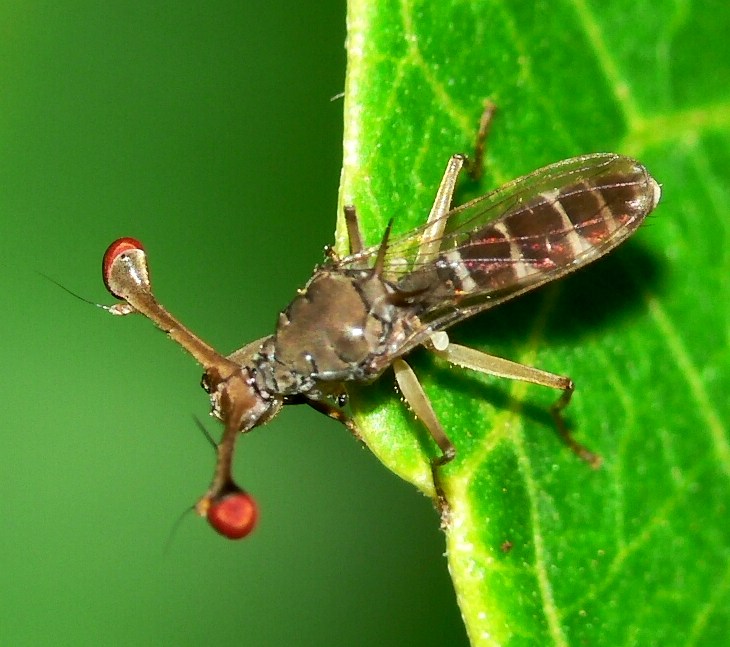
Stalk-eye fly males have stalk eyes that are getting longer, and longer with each generation-- but actually, the males' eyes are ALREADY so long that it interferes with their flying ability (their vision sucks), weighs them down and... well, the long eye stalk is just connected to higher mortality in the flies in general.
Why then are the stalks getting longer?
It's because chicks dig long eye-stalks.
But this "must have a bigger penis" is hardly something reserved to flies (in terms of sexual demorphism). There's a whole species of European deer that went extinct basically because the males had horns that got too big over generations to even lift their head up properly.
Meanwhile, humans are getting taller and taller in recent generations-- and taller still. This despite the fact that height has literally nothing to do with our survival ability/functionality in everyday life, and in fact is related to health problems (once you pass the 7 ft mark). All because chicks dig tall guys.
Just proves how-- in every place, in every time, in every species-- women manage to fuck things up.

Stalk-eye fly males have stalk eyes that are getting longer, and longer with each generation-- but actually, the males' eyes are ALREADY so long that it interferes with their flying ability (their vision sucks), weighs them down and... well, the long eye stalk is just connected to higher mortality in the flies in general.
Why then are the stalks getting longer?
It's because chicks dig long eye-stalks.
But this "must have a bigger penis" is hardly something reserved to flies (in terms of sexual demorphism). There's a whole species of European deer that went extinct basically because the males had horns that got too big over generations to even lift their head up properly.
Meanwhile, humans are getting taller and taller in recent generations-- and taller still. This despite the fact that height has literally nothing to do with our survival ability/functionality in everyday life, and in fact is related to health problems (once you pass the 7 ft mark). All because chicks dig tall guys.
Just proves how-- in every place, in every time, in every species-- women manage to fuck things up.
Cresselia~~
Junichi Masuda likes this!!
Oh, deer....Not all things in nature are actually advantageous.

Stalk-eye fly males have stalk eyes that are getting longer, and longer with each generation-- but actually, the males' eyes are ALREADY so long that it interferes with their flying ability (their vision sucks), weighs them down and... well, the long eye stalk is just connected to higher mortality in the flies in general.
Why then are the stalks getting longer?
It's because chicks dig long eye-stalks.
But this "must have a bigger penis" is hardly something reserved to flies (in terms of sexual demorphism). There's a whole species of European deer that went extinct basically because the males had horns that got too big over generations to even lift their head up properly.
Meanwhile, humans are getting taller and taller in recent generations-- and taller still. This despite the fact that height has literally nothing to do with our survival ability/functionality in everyday life, and in fact is related to health problems (once you pass the 7 ft mark). All because chicks dig tall guys.
Just proves how-- in every place, in every time, in every species-- women manage to fuck things up.
Reminds me how birds find birds with long tails attractive.
Some scientists cut the tail feathers of some male birds and used it to extend tails of other male birds, then the females got all crazy for the extended tails.

^Clearly built for performance
(Hummingbird with longest tail)
The Mantis Shrimp
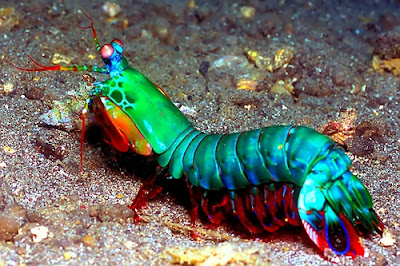
They are very glorious to look at, but they are deadly. I call them "The Chuck Norris of the Sea" They have two raptorial appendages on the front of its body. They accelerate the same velocity as the same as the gunshot from a twenty-two caliber rifle, and in less than three-thousandths of a second can strike prey with 1,500 Newtons of force. Their limbs move so quickly the water around them boils in a process known as supercavitation. When these cavitation bubbles collapse it produces and undersea shock wave that can kill prey EVEN if it misses it's target.
The force of these bubbles also produce insane temperatures, several thousand kelvin, and even emit light also known as sonoluminescence. Now, most aquariums don't have mantis shrimps because they tend to either kill every creature it shares a tank with or it breaks the aquarium causing to flood the aquarium and causes many many people to panic.

They are very glorious to look at, but they are deadly. I call them "The Chuck Norris of the Sea" They have two raptorial appendages on the front of its body. They accelerate the same velocity as the same as the gunshot from a twenty-two caliber rifle, and in less than three-thousandths of a second can strike prey with 1,500 Newtons of force. Their limbs move so quickly the water around them boils in a process known as supercavitation. When these cavitation bubbles collapse it produces and undersea shock wave that can kill prey EVEN if it misses it's target.
The force of these bubbles also produce insane temperatures, several thousand kelvin, and even emit light also known as sonoluminescence. Now, most aquariums don't have mantis shrimps because they tend to either kill every creature it shares a tank with or it breaks the aquarium causing to flood the aquarium and causes many many people to panic.
Last edited:
Only the punchers can break aquarium glass, and only larger specimens.
Mantis shrimp come in two wide categories: punchers that use blunt striking appendages to smash shellfish, and stabbers that use sharp spines to impale fast prey such as shrimp and fish.
Both types have their weapons powered by that incredible strike-- the fastest limb movement and the fastest ANY movement in the animal kingdom (even more incredible that it happens against water resistance).
Mantis shrimp also have some of the most complex eyes in the animal kingdom. Someone else can go into that though.
Mantis shrimp come in two wide categories: punchers that use blunt striking appendages to smash shellfish, and stabbers that use sharp spines to impale fast prey such as shrimp and fish.
Both types have their weapons powered by that incredible strike-- the fastest limb movement and the fastest ANY movement in the animal kingdom (even more incredible that it happens against water resistance).
Mantis shrimp also have some of the most complex eyes in the animal kingdom. Someone else can go into that though.
Last edited:
Cresselia~~
Junichi Masuda likes this!!
In fact, while humans have 3 types of cone cells for detecting colour, Mantis Shrimps have 11 types of cone cells!Mantis shrimp also have some of the most complex eyes in the animal kingdom. Someone else can go into that though.
They can even see X-ray-- as in, way more than the visible spectrum of humans!!




















